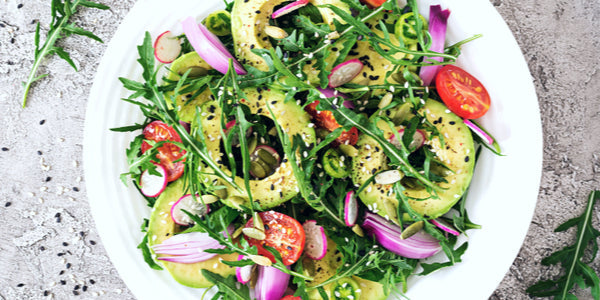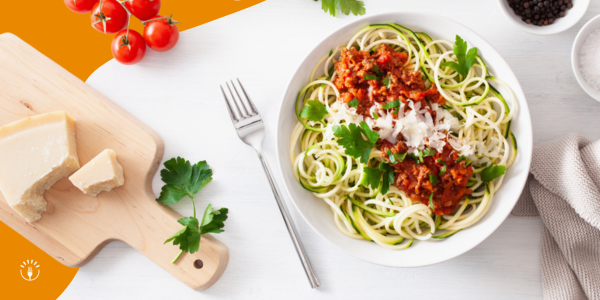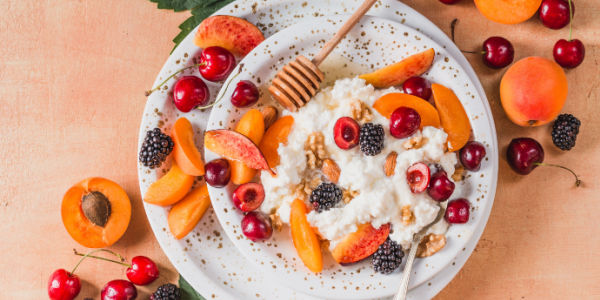
Many shy away from salads because they are unsure of how to make a good salad. Others are unaware of the difference between healthy and unhealthy salad toppings.
Once aware of the health benefits of salads, though, most people are eager to get more greens. (And they might just become a mealtime staple!)
Read on to learn about what makes salads such a nutritious option! Also find out how to make a great salad, from the greens to the toppings.
Benefits of Salads
According to current health recommendations, most people should be eating more salads. Adding leafy greens to the menu each day can be both quick and easy, not to mention they are naturally low in calories while remaining high in nutrients which can be extra helpful when trying to manage weight.
Leafy, salad greens are a nutritional powerhouse full of many vitamins and minerals. They are considered an important component of a healthy and balanced eating pattern.
Over the years, salad bars have even been placed in schools to promote higher intakes of fruits and vegetables because of the bounty of vitamins and minerals they offer.
Nutrient-Rich
Salad greens can offer year-round sources of the following nutrients and other substances:
• Vitamin A
• Vitamin C
• B-vitamins, including folate
• Vitamin K
• Antioxidants
• Calcium
• Potassium
• Fiber
• Phytonutrients
Plant-Based
Salads are a central part of a whole food, plant-based diet that can help to achieve weight loss without focusing on restriction.
Insufficient intake of fruits and vegetables has been included in a recent Global Burden of Disease study as being one of the top 10 risk factors for chronic disease. Therefore, learning how to make a proper salad could be an important step to better health!
Convenient and Low-Calorie
Salad greens, especially leafy greens, are a healthy choice especially when it comes to cholesterol, calories, and sodium.
Plus, delicious and healthy salad recipes like these mason jar salads can easily be taken to-go. Not only are they sustainable, but mason jar salads also make storing salad in the fridge that much easier.
How to Make a Good Salad
Research shows that lack of sensory appeal may be a big reason salads are not being eaten. The good news is the possibilities are pretty much endless when it comes to nutritious salad creations.
The following steps can help when making a tasty, flavorful, nutrient-rich salad dish!
1. Make the Salad Base
Mix and match leafy greens to make the green salad base. Popular favorite salad greens include arugula, kale, iceberg lettuce, mixed greens, red leaf lettuce, romaine lettuce, and spinach.
2. Garnish with Fruits and Veggies
Vibrant fruits and veggies are great things to add to salad for a boost of nutrients, texture, flavor. This step is very forgiving as well, and it's okay to get creative and try different techniques! Produce can be chopped, diced, shredded, thinly sliced, and served in a variety of colors.
Depending on whether a sweet or more savory salad is on the menu, experiment with any combination of the following:
• Apple
• Artichoke hearts
• Avocado
• Beets
• Bell pepper
• Bok choy
• Broccoli
• Cauliflower
• Carrot
• Celery
• Corn
• Cucumber
• Dried fruits or Raisins
• Fresh berries
• Grapes
• Mandarin Oranges
• Melon
• Mushrooms
• Red onion
• Pear
• Radishes
• Red cabbage
• Snap or snow peas
• Sweet potato
• Tomatoes
• Water chestnuts
• Zucchini
3. Add a Bit of Protein (If You Wish)
Next, an addition of meat, seafood, or plant-based protein to the salad on the menu can transform it from a mere appetizer to the main dish.
• Meat-eaters can enjoy options such as lean meats like chicken or turkey. Shredded beef, boiled eggs, sliced ham, grilled salmon, shrimp, and tuna are also delicious additions to play around with.
• Vegetarian and vegan options include tasty additions like black beans, chickpeas, edamame, kidney beans, navy beans, tofu, nuts, and nut butters.
4. Dress it Up
It is easy to go overboard when it comes to salad dressing. Don’t forget that a little bit goes a long way, and aim for no more than 2 tablespoons.
The previous steps provide plenty of flavor, and so dressing is really just a complementary garnish. Great options that are lower in saturated fat, sodium, and sugar include:
• Homemade herb & oil-based dressings
• Olis such as avocado and olive oil
• Yogurt-based dressings
• Salsa
• Fresh or dried herbs
• Lime or lemon juice
Unsure where to start? Try these 10 healthy homemade salad dressings, including slightly sweet and spicy options!
Unhealthy & Healthy Salad Toppings
Many popular salad toppings can add a ton of calories, even if they seem to come in small packages. Croutons, cheese, and sugared nuts should be used sparingly.
Instead, try some of the following toppings to add flavor while also helping to balance out the meal:
• Grains: bulgur, farro, quinoa, wheat berries
• Nuts and Seeds: almonds, cashews, peanuts, pecans, pistachios, pumpkin seeds, sunflower seeds, walnuts
• Other: avocado, fresh herbs, homemade whole grain croutons, olives
Build a delicious salad easily using the simple tips above, and do not be afraid to mix and match until you create a fabulous combination of healthy flavors. Get greens in while adding some of your favorite foods to the plate, too.
Overall, salads are great for every season and are a key part of a healthy, plant-based diet!
References:
Academy of Nutrition and Dietetics staff registered dietitian nutritionists. Smart Tips to Build a Healthy Salad. Academy of Nutrition and Dietetics. 2019. https://www.eatrightpro.org/-/media/eatright-files/nationalnutritionmonth/handoutsandtipsheets/nutritiontipsheets/2020/smart-tips-for-building-a-healthy-salad_final.pdf?la=en&hash=F94E288FC9D036DA3D09C54193C54D85D886EE86.
Bruening M, Adams MA, Ohri-Vachaspati P, Hurley J. School-Level Practices and Perceptions Associated With Salad Bars in Schools. Journal of School Health. 2018;88(6). https://doi.org/10.1111/josh.12624.
Ellis E. Build a Healthy Salad. Academy of Nutrition and Dietetics. 2020. Accessed at https://www.eatright.org/food/planning-and-prep/snack-and-meal-ideas/healthy-salads.
Greger M. A Whole Food Plant-Based Diet Is Effective for Weight Loss: The Evidence. American Journal of Lifestyle Medicine. 2020. https://doi.org/10.1177/1559827620912400
Harvard Health Letter. Salad greens: Getting the most bang for the bite. Harvard Health Publishing. 2018. https://www.health.harvard.edu/staying-healthy/salad-greens-getting-the-most-bang-for-the-bite.
Spence C. Gastrophysics: Nudging consumers toward eating more leafy (salad) greens. Food Quality and Preference. 2020;80. https://doi.org/10.1016/j.foodqual.2019.103800







